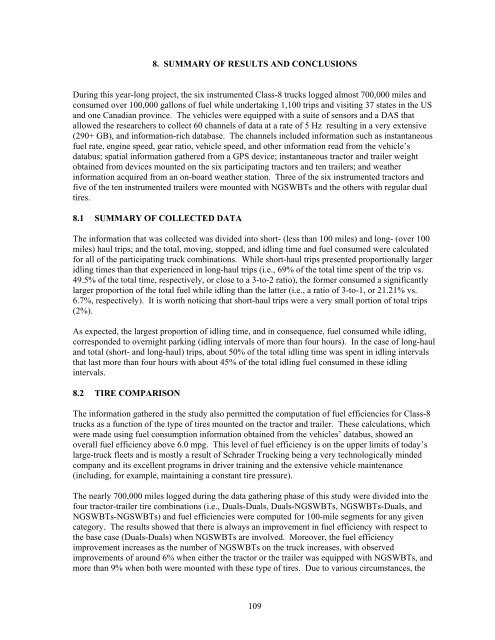Class-8 Heavy Truck Duty Cycle Project Final Report - Center for ...
Class-8 Heavy Truck Duty Cycle Project Final Report - Center for ...
Class-8 Heavy Truck Duty Cycle Project Final Report - Center for ...
You also want an ePaper? Increase the reach of your titles
YUMPU automatically turns print PDFs into web optimized ePapers that Google loves.
8. SUMMARY OF RESULTS AND CONCLUSIONS<br />
During this year-long project, the six instrumented <strong>Class</strong>-8 trucks logged almost 700,000 miles and<br />
consumed over 100,000 gallons of fuel while undertaking 1,100 trips and visiting 37 states in the US<br />
and one Canadian province. The vehicles were equipped with a suite of sensors and a DAS that<br />
allowed the researchers to collect 60 channels of data at a rate of 5 Hz resulting in a very extensive<br />
(290+ GB), and in<strong>for</strong>mation-rich database. The channels included in<strong>for</strong>mation such as instantaneous<br />
fuel rate, engine speed, gear ratio, vehicle speed, and other in<strong>for</strong>mation read from the vehicle’s<br />
databus; spatial in<strong>for</strong>mation gathered from a GPS device; instantaneous tractor and trailer weight<br />
obtained from devices mounted on the six participating tractors and ten trailers; and weather<br />
in<strong>for</strong>mation acquired from an on-board weather station. Three of the six instrumented tractors and<br />
five of the ten instrumented trailers were mounted with NGSWBTs and the others with regular dual<br />
tires.<br />
8.1 SUMMARY OF COLLECTED DATA<br />
The in<strong>for</strong>mation that was collected was divided into short- (less than 100 miles) and long- (over 100<br />
miles) haul trips; and the total, moving, stopped, and idling time and fuel consumed were calculated<br />
<strong>for</strong> all of the participating truck combinations. While short-haul trips presented proportionally larger<br />
idling times than that experienced in long-haul trips (i.e., 69% of the total time spent of the trip vs.<br />
49.5% of the total time, respectively, or close to a 3-to-2 ratio), the <strong>for</strong>mer consumed a significantly<br />
larger proportion of the total fuel while idling than the latter (i.e., a ratio of 3-to-1, or 21.21% vs.<br />
6.7%, respectively). It is worth noticing that short-haul trips were a very small portion of total trips<br />
(2%).<br />
As expected, the largest proportion of idling time, and in consequence, fuel consumed while idling,<br />
corresponded to overnight parking (idling intervals of more than four hours). In the case of long-haul<br />
and total (short- and long-haul) trips, about 50% of the total idling time was spent in idling intervals<br />
that last more than four hours with about 45% of the total idling fuel consumed in these idling<br />
intervals.<br />
8.2 TIRE COMPARISON<br />
The in<strong>for</strong>mation gathered in the study also permitted the computation of fuel efficiencies <strong>for</strong> <strong>Class</strong>-8<br />
trucks as a function of the type of tires mounted on the tractor and trailer. These calculations, which<br />
were made using fuel consumption in<strong>for</strong>mation obtained from the vehicles’ databus, showed an<br />
overall fuel efficiency above 6.0 mpg. This level of fuel efficiency is on the upper limits of today’s<br />
large-truck fleets and is mostly a result of Schrader <strong>Truck</strong>ing being a very technologically minded<br />
company and its excellent programs in driver training and the extensive vehicle maintenance<br />
(including, <strong>for</strong> example, maintaining a constant tire pressure).<br />
The nearly 700,000 miles logged during the data gathering phase of this study were divided into the<br />
four tractor-trailer tire combinations (i.e., Duals-Duals, Duals-NGSWBTs, NGSWBTs-Duals, and<br />
NGSWBTs-NGSWBTs) and fuel efficiencies were computed <strong>for</strong> 100-mile segments <strong>for</strong> any given<br />
category. The results showed that there is always an improvement in fuel efficiency with respect to<br />
the base case (Duals-Duals) when NGSWBTs are involved. Moreover, the fuel efficiency<br />
improvement increases as the number of NGSWBTs on the truck increases, with observed<br />
improvements of around 6% when either the tractor or the trailer was equipped with NGSWBTs, and<br />
more than 9% when both were mounted with these type of tires. Due to various circumstances, the<br />
109
















